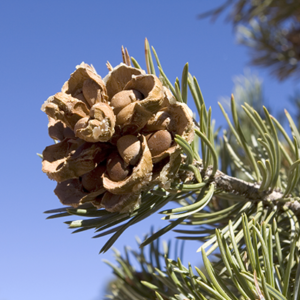 Tis the season… for pine nuts that is! As we approach the winter holidays here in Colorado, we find that many dishes incorporate pine nuts into their recipes. These vanilla-colored morsels are commercially imported from places like China or Italy and are very expensive to purchase. You might be asking yourself why there aren’t American pine nuts? Well there are, you just have to go out and find them!
Tis the season… for pine nuts that is! As we approach the winter holidays here in Colorado, we find that many dishes incorporate pine nuts into their recipes. These vanilla-colored morsels are commercially imported from places like China or Italy and are very expensive to purchase. You might be asking yourself why there aren’t American pine nuts? Well there are, you just have to go out and find them!
All pine trees have edible nuts, but here in Colorado, the one that reigns supreme is the Pinion Pine nut. The Pinion Pine thrives in high mountain deserts from elevations of 5,000 ft to 7,000 ft on the Eastern slopes of the Rocky Mountains. Their harvest season starts around Labor Day and lasts until the end of October. If you are a Colorado resident, you do not need a permit to harvest them for personal use, which is considered 25 pounds or less. If you plan to re-sell them or collect over 25 pounds, you can pick up a permit from the Bureau of Land Management or the USFS.
Start Your Harvest
The first and most important step to harvesting is finding a good set of trees. Pinion Pines can be found throughout the Great Basin, but the abundance of nuts varies by year and geographical location, so it is important to scout an area around mid-summer and then return in September and October to harvest. When you are ready to harvest, buy a cheap pair of gloves that you won’t mind ruining. The pine cones release a sweet-smelling resin that can destroy your clothes and wreck your gloves. If you do happen to get some pitch on your skin, cooking oil will remove it more easily than heavy scrubbing.
Pine Cone Retrieval
When it comes time to harvest, bring a ladder and brown paper bags to put the cones in. Pick the cones off the tree individually and place them into the brown bags. Do not cut off a whole tree branch!! This will hinder the trees’ ability to be productive and is unnecessary for cone collection. If you pick the cones before they have opened place them in a burlap sack and leave them in the sun. Be sure to rotate the bags daily in order to ensure even heating of the cones. If you picked the cones in September, it could take up to three weeks for them to open fully.
The Final Payoff
There are a few methods to remove the nuts once the pine cones are open. The easiest is just to remove each nut by hand. This is a little messy, but it is the most controlled method. A more fun way is to put the cones in a wicker basket and toss them in the air. The wind will carry away the light cone and the heavy nut will drop back into the basket. Freeze the nuts in their shells and they will last up to two years. These nuts are a tasty source of protein and can be eaten like a sunflower seed or de-shelled and used in restaurant quality meals. However you enjoy your pine nuts, collecting them yourself will definitely make them all the tastier. Happy Holidays!
Rebecca Indeck is a naturalist at Walking Mountains Science Center in Avon, Colorado. Originally from New Jersey, Rebecca loves helping people of all ages connect to nature and get outdoors.









